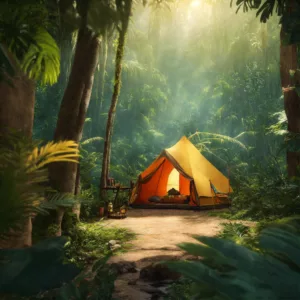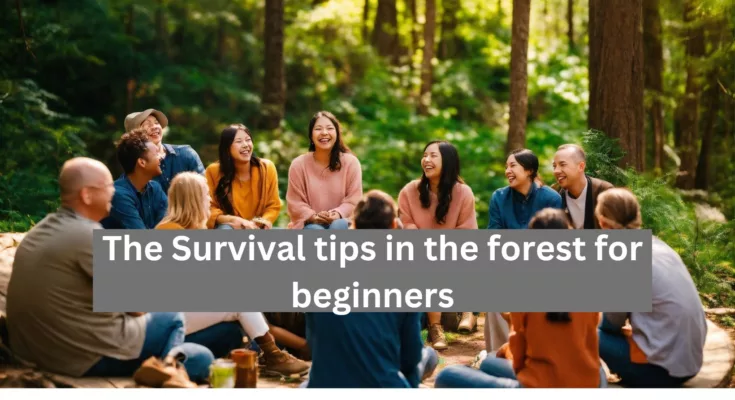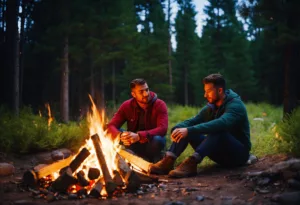Surviving in the forest requires a combination of knowledge, skills, and the right mindset. Whether you are an outdoor enthusiast, a hiker, or someone who simply wants to be prepared for unexpected situations, understanding basic survival tips in the forest is essential. In this article, we will explore crucial aspects of forest survival for beginners, providing a comprehensive guide to help you navigate and thrive in the wilderness.
Survival tips encompass a range of skills and knowledge aimed at sustaining life in challenging environments. In the context of the forest, these tips are crucial for anyone spending time outdoors.
Comprehensive gaudiness For Beginners
Preparation:
Before venturing into the forest, thorough preparation is crucial. This involves:
- Research: Familiarize yourself with the specific ecosystem you’ll be exploring, including its flora and fauna, potential hazards, and weather patterns.
- Map and compass: Invest in a detailed map of the area and learn basic compass navigation skills. This will ensure you don’t get lost.
- First-aid kit: Assemble a comprehensive first-aid kit to address potential injuries and illnesses.
- Essential gear: Pack a sturdy backpack, appropriate clothing and footwear, shelter materials, a water purifier, a fire starter, and a survival knife.
- Emergency communication: Inform someone about your planned route and estimated return time. Consider carrying a satellite communicator for remote areas.

Shelter:
Finding or building a suitable shelter is paramount for survival. Consider these options:
- Natural shelters: Look for caves, overhangs, or fallen trees that offer protection from the elements. Learn how to identify and utilize natural materials like leaves and branches for additional cover.
- Emergency shelters: Pack a lightweight tarp or emergency blanket to create a temporary shelter. Learn basic construction techniques for a quick and secure haven.
Water:
Hydration is crucial for survival. Here’s how to ensure you have access to clean water:
- Carry enough water: Bring enough water for your anticipated journey, considering additional requirements for strenuous activities or hot weather.
- Purify water: Learn how to safely purify water from sources like streams or ponds using boiling, filtration, or chemical treatment.
- Locate natural sources: Identify potential sources of clean water, such as springs or rainwater collection points.
Fire:
Fire provides warmth, light, and the ability to cook food and boil water. Here’s how to start a fire effectively:
- Gather tinder and kindling: Collect dry leaves, twigs, bark, and other flammable materials.
- Choose a safe location: Build your fire away from flammable materials and ensure proper ventilation.
- Learn various fire-starting methods: Practice using matches, lighters, friction-based methods like the bow drill, and flint and steel.
Food:
Finding food in the forest requires knowledge and resourcefulness:
- Foraging: Learn how to identify and safely consume edible wild plants, fruits, and nuts. Be aware of poisonous look-alikes and consult reliable guides.
- Hunting and fishing: If permitted and practiced ethically, hunting and fishing can provide valuable protein. Learn proper techniques and ensure you have the necessary equipment and skills.
- Conserve food: Store and ration your food supply carefully to ensure it lasts throughout your journey.
Importance of Forest Survival Skills
Understanding basic survival skills in the forest is not just for extreme scenarios. It enhances your outdoor experience, promotes safety, and ensures you can handle unexpected challenges effectively.
Essential Gear for Forest Survival
Choosing the Right Clothing
Proper clothing is the first line of defense in the wilderness. Learn how to select appropriate clothing for different weather conditions, ensuring comfort and protection.
Tools and Equipment
From multi-tools to first aid kits, having the right gear is essential. We’ll explore the must-have items for your survival backpack and their specific uses.
Reliable Backpack
Your backpack is your survival hub. Discover the features of a reliable backpack and how to pack it efficiently for different scenarios.
Signaling for Help:
Knowing how to signal for help in an emergency can be life-saving:
- Learn distress signals: Familiarize yourself with internationally recognized distress signals like SOS.
- Use mirrors and whistles: Carry a signaling mirror and whistle to attract attention and signal for help.
- Build a signal fire: Create a large, visible fire that can be seen from a distance.
Additional Survival Tips:
- Stay calm and think clearly: Panicking can cloud judgment and hinder your ability to make sound decisions.
- Conserve energy: Avoid unnecessary exertion to preserve your energy for critical tasks.
- Pay attention to your surroundings: Be aware of potential hazards like poisonous plants, animals, and weather changes.
- Observe and learn: Adapt and learn from your experiences in the forest to improve your survival skills.
Mental Preparedness
Coping with Isolation and Stress: Survival situations can be mentally challenging. Discover coping mechanisms for dealing with isolation and stress in the forest.
Positive Mindset in Survival Situations: A positive mindset is a powerful asset. Explore how maintaining optimism contributes to better outcomes in survival scenarios.
Survival Stories and Lessons
- Real-Life Stories of Survival in the Forest: Inspiration often comes from real experiences. Explore survival stories that offer valuable lessons for beginners in forest survival.
- Lessons Learned from Successful Survival Situations: Analyze the lessons learned from successful forest survival situations, extracting wisdom for your outdoor adventures.
- Inspiration for Beginners in Forest Survival: Embark on your forest survival journey with inspiration from those who have navigated and thrived in challenging situations.
Conclusion
Survival in the forest is a continuous learning process. Respect the environment, prioritize your safety, and always be prepared for the unexpected. With the right knowledge, skills, and a positive attitude, you can navigate the green wilderness and emerge from the experience with newfound confidence and respect for the natural world.
Next
FAQs
Q: Is it necessary to join a survival course for beginners?
A: While not mandatory, joining a survival course enhances practical skills and builds confidence.
Q: What should I do if I encounter a wild animal in the forest?
A: Remain calm, avoid direct eye contact, and slowly back away. Do not run, as it may trigger a chase response.
Q: How can I ensure I leave no trace while camping in the forest?
A: Follow Leave No Trace principles, pack out all waste, minimize campfire impact, and respect wildlife habitats.
Q: What’s the most important item to have in a forest survival kit?
A: A reliable multi-tool is versatile and can be invaluable in various survival situations.
Q: Can beginners effectively build a shelter using natural resources?
A: Yes, with the right knowledge and practice, beginners can learn to construct basic shelters using materials found in the forest.






One Comment on “The Survival tips in the forest for beginners”